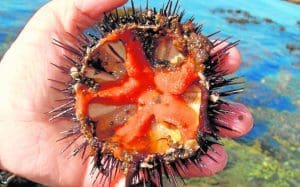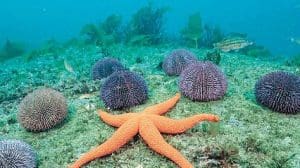The ocean is home to a vast array of unique and fascinating creatures, and one of the most intriguing is undoubtedly the sea urchin. With its distinctive spiny appearance and important role in the marine food chain, the sea urchin is a key player in the biodiversity of our oceans. In this article, we will explore the unique characteristics of the sea urchin, including its physical appearance, behavior, and habitat. We will also delve into its vital role in the marine food chain, as both a predator and prey species. Join us as we discover the fascinating world of the sea urchin and its crucial place in the intricate web of ocean life.
Contents
Characteristics of the Sea Urchin.
Sea urchins are fascinating marine animals that belong to the class Echinoidea. They have a unique physical appearance that sets them apart from other sea creatures. Here are some of the key characteristics of the sea urchin:
Physical Appearance:
Sea urchins are typically round or oval-shaped and covered in spines. Their spines are used for protection from predators and to help them move across the ocean floor. They also have a mouth located on their underside, surrounded by five teeth that they use to scrape and grind their food.
Skeletal System:
The spines of a sea urchin are connected to a hard, calcified shell called a test. The test is composed of calcium carbonate and is divided into several plates that are arranged in a circular pattern around the animal’s body. The test provides protection for the sea urchin’s internal organs and serves as an attachment point for its muscles.
Behavior:
Sea urchins are primarily nocturnal and spend most of their day hiding in crevices or burrows to avoid predators. At night, they emerge to feed on algae, kelp, and other small organisms.
Habitat:
Sea urchins are found in oceans all over the world, from shallow waters to depths of over 16,000 feet. They prefer rocky areas with strong currents where they can anchor themselves to the substrate with their spines.
Reproduction:
Sea urchins reproduce by releasing eggs and sperm into the water, where fertilization occurs externally. The larvae then undergo a metamorphosis process before settling on the ocean floor and developing into adults.
Feeding and role in the food chain.
Feeding and the role in the food chain are crucial aspects of the biology of sea urchins. As herbivores, sea urchins feed on algae, kelp, and other small organisms, and their feeding behavior plays a vital role in the marine food chain.
Sea urchins use their five teeth to scrape and grind their food, which makes them efficient grazers of algae and other vegetation. Their feeding behavior can have a significant impact on the abundance and diversity of plant and animal species in marine ecosystems.
At the same time, sea urchins themselves are an important food source for many predators, including sea otters, starfish, and certain fish species. As a result, sea urchins play an important role in transferring energy through the marine food chain and maintaining the balance of marine ecosystems.
In addition to their role as prey, sea urchins can also act as predators. Some species of sea urchins are known to feed on small invertebrates and even other sea urchins. This predatory behavior can have an impact on the abundance and distribution of other species in the ecosystem.
What happens if you get pricked by a sea urchin?.
If you get pricked by a sea urchin, it can be a painful and potentially dangerous experience. Sea urchin spines are sharp and can easily break off in the skin, causing irritation, inflammation, and infection.
Here are some general things to know about what happens if you get pricked by a sea urchin:
- Immediate Symptoms: When a sea urchin spine penetrates the skin, it can cause immediate pain and bleeding. Depending on the location of the injury, the area around the wound may also swell, turn red, and become tender to the touch.
- Spine Removal: If a sea urchin spine is left in the skin, it can cause further irritation and infection. It is important to remove any broken spines as soon as possible using clean, sterilized tweezers or a needle. If you are unable to remove the spine, seek medical attention.
- Infection Risk: Sea urchins are known to carry bacteria that can cause infection, so it is important to keep the wound clean and monitor it for signs of infection, such as redness, warmth, and pus.
- Treatment: To alleviate the pain and reduce the risk of infection, soak the affected area in hot water for 30 to 90 minutes. If the pain persists, over-the-counter pain relievers or topical creams may be helpful. Seek medical attention if the wound becomes infected or if you experience severe pain, swelling, or difficulty breathing.
Ecological and Economic Importance of the Sea Urchin.
Sea urchins play an important ecological and economic role in marine ecosystems around the world. As herbivores, they help to maintain the balance of marine food webs by controlling the growth of algae and other vegetation. At the same time, they are an important source of food and income for humans in many coastal communities.
Here are some general points about the ecological and economic importance of the sea urchin:
Ecological Importance:
Sea urchins are important herbivores in many marine ecosystems, helping to control the growth of algae and other vegetation. This role is particularly important in areas where overgrowth of algae can lead to a decline in biodiversity and even the collapse of entire ecosystems. In addition, sea urchins provide food for a variety of predators, including sea otters, starfish, and certain fish species, making them an important part of marine food webs.
Economic Importance:
Sea urchins are an important source of income for many coastal communities around the world. They are harvested for their roe (eggs), which is considered a delicacy in many cultures and can command high prices in seafood markets. In addition, sea urchin shells are used for decorative purposes and in the manufacture of jewelry and other products.
Fisheries Management:
Because of the economic importance of sea urchins, many countries have established regulations and management practices to ensure sustainable harvesting of this resource. These measures can include limits on the number of sea urchins that can be harvested, seasonal closures, and size restrictions to protect juvenile sea urchins. These practices help to ensure the long-term viability of sea urchin populations and the communities that rely on them.
Conservation and threats to the sea urchin.
Conservation of sea urchins is important to maintain their ecological and economic roles in marine ecosystems. However, sea urchins are facing a number of threats that are impacting their populations.
Here are some general points about conservation and threats to the sea urchin:
Overfishing:
Overfishing is one of the biggest threats to sea urchin populations. When too many sea urchins are harvested, it can lead to a decline in their numbers and disrupt the balance of marine ecosystems. Sustainable management practices, such as fishing quotas and size limits, can help to prevent overfishing.
Habitat destruction:
Habitat destruction, such as the destruction of kelp forests, can also threaten sea urchin populations. Kelp forests provide important habitat for sea urchins and other marine species, and their destruction can lead to declines in sea urchin populations.
Pollution:
Pollution can have a number of negative impacts on sea urchins, including the destruction of their habitat, the contamination of their food sources, and direct harm to their bodies. Pollution can also impact the health of humans who consume sea urchins.
Climate change:
Climate change is another threat to sea urchin populations. Rising temperatures and ocean acidification can impact the growth and reproduction of sea urchins, and can also lead to changes in their habitat.
If you want to learn more about marine curiosities, I invite you to visit our website Seafood Peddler.


